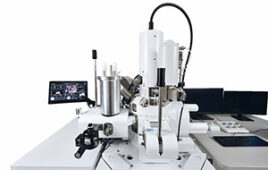 A fume hood is a workstation designed to limit exposure to hazardous fumes. Fume hoods are typically mounted over work surfaces. They partially enclose the work surface, leaving the front open that so the worker can reach inside. The interior volume is ventilated so that there is a constant flow of air into the open side, preventing the escape of fumes. Fume hoods are also known as fume cupboards or fume closets.
A fume hood is a workstation designed to limit exposure to hazardous fumes. Fume hoods are typically mounted over work surfaces. They partially enclose the work surface, leaving the front open that so the worker can reach inside. The interior volume is ventilated so that there is a constant flow of air into the open side, preventing the escape of fumes. Fume hoods are also known as fume cupboards or fume closets.
Ventilation may be either ducted or recirculating, otherwise known as ductless. Ducted systems vent the air and fumes externally, while recirculating systems use filtration to make it safe before recirculating the air into the workspace. Ducted fume hoods have much higher installation costs but are often better suited to heavy use in industry.
A low-flow alarm is an important safety feature to notify the user if a blockage or fan failure prevents proper extraction of fumes. There may also be an alarm signal if the enclosure is not properly closed.
Fume hoods come in various widths, from less than one meter for a single user up to two or more meters for several people to use at the same time. The height of the front opening is often adjustable with a vertically sliding glass door. The sides may also be glass to allow other people to view work being carried out, which can be particularly useful in education and training. Because the structure of a fume hood blocks room lighting, internal lighting is often built in.
Different materials may be used to line a fume hood. Polypropylene is often the best material for many applications. Phenolic resin, epoxy resin and glass reinforced plastic are also good general-purpose materials. Stainless steel is a good choice for applications requiring durability, heat resistance and ease of decontamination.
When dealing with the most hazardous substances, a glovebox may be used. A glovebox is a completely sealed and transparent enclosure with gloves which allow a user to manipulate objects inside the box. A negative air pressure in the glove box can prevent the escape of any gas through small leaks.





An improperly designed or installed hood may be more dangerous than no hood at all (same with a glove box). I know this is simple overview, but I think it is important to at least mention – for example, hoods need laminar (inlet) flow – turbulent flow can push contaminants back into the lab/work environment.
Regarding glove boxes – there is no such thing as negative pressure – perhaps it would be better to (more accurately) simply refer to lower or differential pressure. And of course glove boxes are often held at a slightly higher than atmospheric pressure (often resulting in the gloves reaching out!). Again, I know you are trying to give an overview – but oversimplification can be misleading, and lead to safety issues.